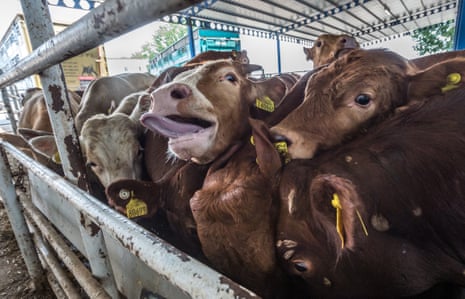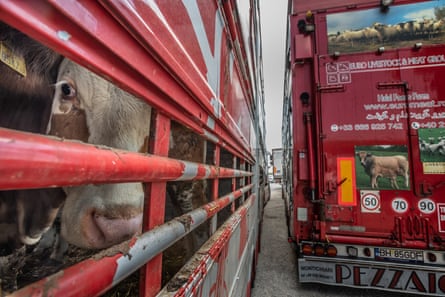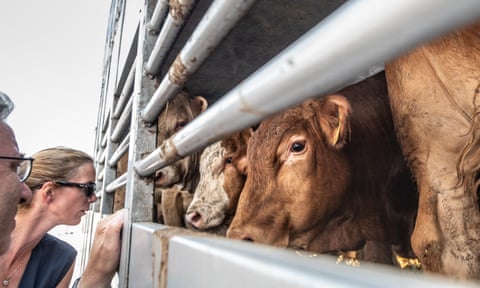At the Kapikule border crossing between Turkey and Bulgaria, Lesley Moffat charges forward, clipboard in hand, marching alongside the parked lorries loaded with live cows and sheep waiting in this no man’s land to be exported from the EU. Sometimes, the animals are left on the lorries for days, stuck inside metallic freight containers barely shielded from the blinding sun as truckers, bureaucrats, importers and exporters haggle over paperwork and fees.
The cows struggle to bring their heads close to the fresh air. Their containers are filled with urine and manure, levels of ammonia steadily rising inside the trailers as journeys wear on. Moffat – the founder of the Dutch-based charity Eyes on Animals – sticks her hand through the grating of one lorry to check the animals’ water supply. “Look at this,” she says, grabbing at the hay stuck into the water trough and pointing to the dung clogging it. “It gets full of dirty straw and shit, and they can never drink from it,” she says. “The drivers need to give them water in buckets.”

She whips out an electronic thermometer holstered in her satchel and sticks it through the grates. She notes the temperature – over 30C, higher than EU regulations – and jots it down on her checklist as she moves from truck to truck, petting some of the distressed animals on their snouts and even pouring water out of her own bottle for the parched cows. “This one is showing signs of heat stress – its tongue is rolling,” she says, pointing to a cow inside one of the trucks.
For years, she says, authorities have promised to build a shaded grazing area for animals waiting at the border, even showing plans for where the facility is meant to go up. But nothing has happened. “Every year, it’s the same situation here,” she says. “Trucks are arriving when it’s over 30C, even though that’s illegal. There’s just one fire hydrant, no shade, no infrastructure, trucks waiting in the sun all day.”
Demand for meat is rising all over the world, even as the industry faces challenges from animal-rights activists and burgeoning vegetarian and vegan lifestyles in the west. The live export business is thriving. At every moment of the day, animals are being moved huge distances across the planet’s surface. Horses from the US are packed on to transport trucks and sent to be slaughtered in Mexico. Pigs from Canada endure icy temperatures as they wait for long periods at the US frontier. Livestock from central Europe is trucked to the farthest reaches of Russia, where they are slaughtered, fattened or bred. Cows from Australia, Uruguay and Argentina are loaded on to ships and endure weeks-long trips to the Middle East.
The trade is growing rapidly. In the EU alone, exports of live horses, cattle, chicken, sheep, pigs and goats – mostly to Turkey, north Africa and the Middle East – grew 62.5% between 2014 and 2017, to nearly 586m kilograms. Last year, Australia exported 2.85 million livestock worth $1.4bn (£1bn), mostly to Kuwait, Qatar and Indonesia, and numbers are rising. Exports of live sheep rose 21.4% and live calves increased 9.7% between March 2017 and March 2018, according to the Australian Bureau of Statistics.
The trade makes economic sense, catering to people, such as those in Turkey, who are willing to pay a premium for imported meats because they consume far more than they produce. Live animal exports reduce the need to install expensive equipment to keep meat frozen. The EU imports large amounts of fruit and vegetables, and live animal exports help to plug the trade gap.
What’s more, butchers in Muslim countries demand newly slaughtered lamb and beef. “It has to do with the meat consumption culture,” says Jean-Luc Mériaux, the secretary general of the European Livestock and Meat Trades Union (UECBV), a Brussels-based lobbying group that argues the export trade makes an important contribution to the EU’s economy. “They’re looking for very fresh meat, they eat it immediately after the slaughtering. And if we don’t supply the cattle, someone else will – maybe Brazil, Uruguay or Australia.”

But the trade raises some uncomfortable ethical questions. Here at the Turkey/Bulgaria border, the bottleneck where so many animals leave the EU for Turkey and the Middle East, many of the cows are crammed into quarters so tight that they are unable to lie down. Eerily, few of them moo, a possible sign of exhaustion. One cow is bleeding from a raw stump where her horn caught in the railing of the truck and was ripped off.
Moffat is a blur of activity here, talking to truck drivers, trying to offer care for the animals as much as she is able. When she spots a newborn calf in distress (the calf was probably born in transit), she summons a vet from the nearby city of Edirne in north-west Turkey and pays for medical treatment.
Moffat is the granddaughter of cattle farmers in Ontario. They treated their 40 or so cows well, but as a child she watched as global agribusiness moved in and set up industrial conditions for livestock that she considered unbearable for the animals and unhealthy for people consuming their meat. “I learned about factory farming as a 12-year-old,” she says. “It made me an activist right away.”
Now, she physically chases down traders and trucks, often trailing cars for miles, keeping track of how they treat the animals under their care. Her scariest experience came in 2005, while monitoring a businessman in rural Belgium. She was watching him load donkeys on to a truck from across a field. He spotted her. She ran back to her car and he followed with a baseball bat, which he used to smash her car. She sped away with the man in pursuit. “I’ve never driven so fast,” she says. “I was going through these tiny towns at 180km/h.” She finally parked in front of a cafe and called out for help.
Most encounters are far less confrontational. During the hours we spend at the border, several truckers whom Moffat awakens from their naps agree to turn on the fans installed inside the trailers when she points out the temperatures. Others promise to water the animals while waiting for customs papers to come through. Moffat is sympathetic to the plight of the drivers, many of whom would be working in agricultural jobs were it not for the rise of industrial farming. Many of the truckers voice sympathy for the animals and seem eager to cooperate.
“They’re not the ones with the big money,” she says. “They’re not the bosses. They’re forced to drive really long hours, long distances alone, which is illegal, but saves the boss money.”

This is just one of the frontlines on which activists around the world have fought for years. In the 90s, widespread protests in the UK dominated the press. In 1995, a 31-year-old animal rights activist, Jill Phipps, was crushed to death by a lorry during a protest against export of live calves to the Netherlands. The subject has come to the fore because of the Brexit discussions, with Michael Gove, the UK’s environment secretary, consulting on banning livestock exports after the country leaves the EU. It is a move that would not be allowed under EU trading rules. New Zealand has been operating a de facto ban on exports for slaughter since 2003, while activists in Australia are now seeking a ban after using undercover footage to expose the abuses they say go on inside the ships carrying farm animals for slaughter around the world. Cows, they say, are held in containers that fill up with tens of thousands of litres of urine and faeces during hot, weeks-long journeys.
Animal rights advocates insist the trade in live animals is unnecessary and that animals should be raised closer to where they are eaten, or slaughtered and exported as frozen carcasses. “We want to end this cruel and completely outdated trade,” says Reineke Hameleers, the director of Eurogroup for Animals. “Animals are not goods. They are beings.” Jørn Dohrmann, a Danish member of the European parliament who is serving as rapporteur on live animal exports, says the EU should refuse to sell animals to countries when they might be subjected to abuse.
Activists say that guidelines laid down by the EU and member states are quickly discarded from the moment animals are herded on to lorries or ships operated by giant firms. “They can’t move,” says Francesca Porta, of Eurogroup for Animals. “If they fall down, they cannot get up. They are exhausted because the length of journey is very long. They don’t have water, feed, or resting time. For unweaned animals in particular, the mortality rate is high.” The EU is keenly aware of the controversy and is preparing an assessment of how its rules are being implemented, which should be ready by January 2019. Dohrmann travelled to Turkey this month to see the treatment of animals at the border. “I think the European commission is weak on this question,” he says. “You have 28 different set of rules; they are not implemented in the same way in each country.”
The UECBV insists that the industry abides by strict national and European commission legal requirements, while acknowledging occasional “shortcomings” and room for improvement. Mériaux says companies that don’t abide by the rules are not able to operate. “Try to load a truck in France or Ireland in the summer and you will not get permission to go to Turkey because the temperatures are too high,” he says. “You are told to wait a couple of weeks.”

Industry advocates even argue that the activists’ actions lead to unintended consequences. Kirk Leech, executive director of the London-based advocacy group the European Animal Research Association, cites the example of a Dutch company forced to use a rusting, dilapidated Russian tank ferry to move sheep from the coast of Kent to France for halal slaughter because no other shipping firm will move live animals.
“Because the activists made a big campaign about this, they have forced potentially better transport providers such as Eurotunnel not to touch it,” he says. “Eurotunnel moves tanks, alcohol and cigarettes, but they won’t touch animals for food consumption or research purposes because they fear the reputational consequences.”
Only Air France and a few charter planes will fly live animals for research or consumption. Leech cites the case of live animals that needed to travel 300km within Portugal from Lisbon to Porto, but had to be flown via Frankfurt, putting additional stress on the creatures, because the Portuguese national carrier refuses to carry research animals.
Moffat is familiar with these arguments. She admits that sometimes they win and sometimes they lose. “You’ve got to start somewhere, and when it gets cleaned up in one area, it gets a little dirtier in the other area,” she says. She is not about to give up any time soon, though. “It doesn’t matter that these animals are ultimately headed for slaughter,” she says. “Anything that has the desire to live and feels pain we should think twice about making suffer. I see it as enlarging the circle of compassion to include all things that feel pain.”
